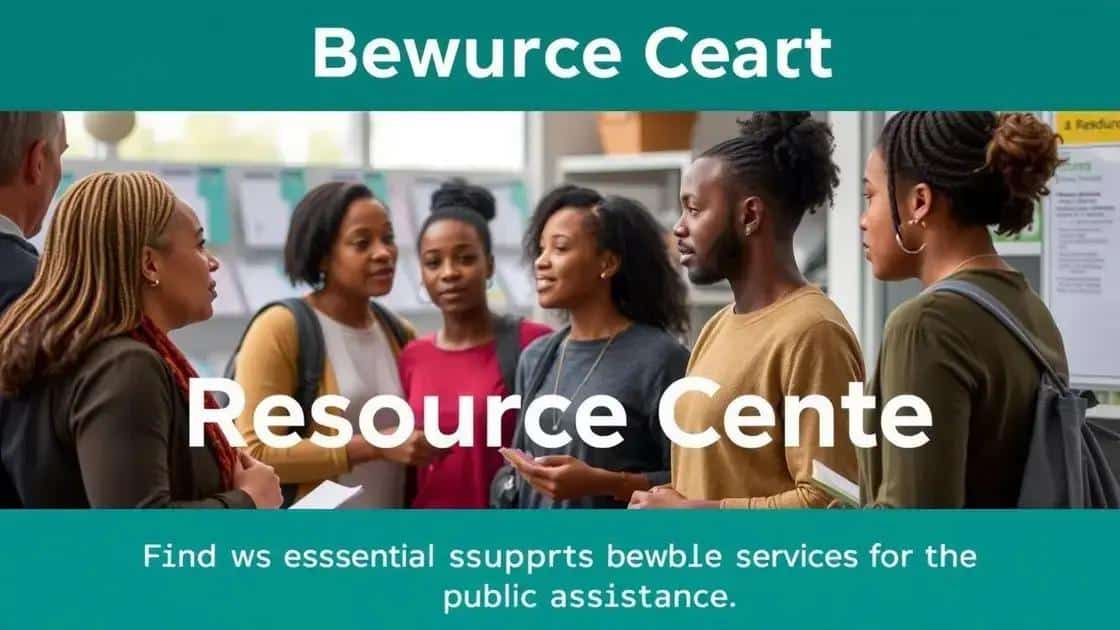development public assistance access: a guide to vital resources

Development public assistance access involves utilizing government-funded programs that provide essential resources like food, housing, and healthcare to eligible individuals and families in need.
Development public assistance access is essential for individuals seeking vital support. Whether it’s food aid, housing assistance, or healthcare, understanding these programs can significantly impact your life. Let’s dive into how to effectively navigate these resources.
Understanding public assistance programs
Understanding public assistance programs can be the first step in gaining access to vital resources. These programs are designed to support individuals and families in need, providing essentials like food, housing, and healthcare.
Different programs exist based on various needs. For instance, programs may focus on food assistance, offering help through food stamps or local food banks. Others may assist with housing costs, helping individuals manage rent or utilities. It’s essential to know what’s available.
Types of Assistance Programs
There are several key categories of public assistance:
- Food Assistance: Programs like SNAP (Supplemental Nutrition Assistance Program) provide monthly food benefits.
- Medical Assistance: Medicaid offers healthcare coverage for eligible low-income individuals and families.
- Housing Assistance: Housing Choice Vouchers help pay for safe and affordable housing.
- Cash Assistance: Temporary Assistance for Needy Families (TANF) supports families with children in need of financial assistance.
The eligibility process varies for each program but generally requires proof of income and other personal information. Keep in mind that many programs aim to help as many people as possible, so don’t hesitate to reach out!
Finding the right resources tailored to your unique situation is crucial. Many local community organizations, such as food banks and shelters, can provide guidance on how to apply and what documentation you may need. Often, they offer assistance with filling out forms and navigating the complexities of the application process, making it easier for you to get the help you deserve.
Stay informed about deadlines and any changes to the application process, as this can impact your access to benefits. Regularly checking official websites and local resources can keep you updated. Remember, public assistance programs are there to support you in challenging times.
Navigating eligibility requirements
Navigating eligibility requirements for public assistance can often feel overwhelming. Understanding what is needed to qualify for these programs is essential to access the support you need.
Most public assistance programs have specific criteria you must meet. Age, income level, and family size are common factors that determine eligibility. For instance, many programs require you to be a resident of the state and a citizen or have legal residency status in the country.
Key Factors in Eligibility
Here are some important factors to consider when assessing your eligibility:
- Income Limits: Each program has a maximum income threshold that you can’t exceed to qualify for assistance.
- Household Size: Your family size can impact the amount of assistance you receive and eligibility.
- Residency Requirements: You often need to prove that you live in the state where you are applying for assistance.
- Work Requirements: Some programs may require you to be actively seeking employment or working a certain number of hours.
Gathering the necessary documentation is also a key step. You will likely need to provide proof of income, identification, and possibly tax documents. Having these ready can streamline the application process significantly. Many people find it helpful to consult with local assistance programs or nonprofits for guidance on completing their applications accurately.
Don’t let confusion hold you back from seeking help. Being aware of your rights and the assistance available is crucial. Resources like community centers and online services can provide valuable information about eligibility requirements. Remember, these programs are designed to help you, so it is worth your time to understand them fully.
Essential resources for accessing assistance

Accessing assistance can be challenging, but knowing where to find essential resources makes the process much easier. Various tools are available to help you connect with the right assistance programs.
One of the most valuable resources is local community organizations. These groups can assist you with information about public assistance programs in your area. They often provide free consultations and help with filling out applications, which can make navigating the system less stressful.
Key Essential Resources
Here are some significant resources to consider:
- Government Websites: Check state and federal websites for detailed information about eligibility and application processes.
- Community Action Agencies: These agencies offer support and services tailored to local needs, making them a great starting point.
- Food Banks: Local food banks can provide immediate support for those struggling to afford groceries.
- Nonprofit Organizations: Many nonprofits focus on specific needs, like housing or healthcare, and can guide you through available services.
Many people find that reaching out to family and friends can also reveal assistance opportunities. Often, they may have insight or resources you weren’t aware of. Social media groups or community forums can serve as platforms where individuals share their experiences and tips regarding public assistance.
In addition, consider utilizing online resources. Various websites offer directories of services tailored to your needs, including assistance for food, housing, and healthcare. These tools can help you quickly find the information you need to apply for support.
Staying informed about local resources and assistance programs is vital. These resources are designed to serve the community, and they can make a substantial difference during challenging times.
The role of community organizations
The role of community organizations in providing public assistance is invaluable. These organizations serve as vital links between individuals and the support they need.
Community organizations offer various services aimed at enhancing the lives of those in need. They provide information about available programs, help with applications, and even offer direct assistance such as food and financial aid.
Services Offered by Community Organizations
Here are some of the key services these organizations provide:
- Application Assistance: Many organizations help individuals fill out forms, ensuring they meet all requirements.
- Resource Coordination: They connect people with food banks, housing options, and medical services in the community.
- Education Programs: Workshops and seminars can help individuals understand their rights and navigate the assistance system.
- Support Groups: These organizations often host groups that provide emotional and practical support.
Building relationships with local community organizations can greatly ease the process of accessing public assistance. They often have staff and volunteers who understand the local landscape of resources, making them a reliable source of information.
Additionally, community organizations foster collaboration and advocacy, working to improve the public assistance system as a whole. They identify needs in the community and advocate for better services and funding, ensuring that essential resources are available to those who require them.
By actively engaging and utilizing community organizations, individuals and families can enhance their chances of receiving the support they deserve. These organizations are dedicated to serving the community and are instrumental in helping navigate the often-complex system of public assistance.
Tips for maximizing benefits
Maximizing benefits from public assistance programs can significantly improve your financial situation. Here are some effective strategies to help you get the most out of these resources.
First, it’s crucial to understand the specifics of each program you are enrolled in. Each program has different eligibility criteria, benefits, and requirements. Familiarize yourself with these details to ensure you are utilizing everything available to you.
Effective Strategies for Maximizing Benefits
Here are some tips to help you get the most from your assistance:
- Keep Records: Document all communications and keep copies of your applications, notices, and any relevant forms.
- Stay Informed: Regularly check for updates on your program’s rules and benefits, as they can change.
- Ask Questions: Don’t hesitate to reach out to program representatives or community organizations to clarify any doubts.
- Utilize Additional Resources: Look into complementary programs that can provide additional support, such as job training or childcare assistance.
Another vital aspect of maximizing benefits is maintaining communication with your caseworker, if applicable. Providing all required documentation on time and being proactive during the application process can help avoid delays and errors. Regular follow-ups can also ensure that your application is being processed smoothly.
Moreover, consider participating in workshops or informational sessions offered by community organizations. These sessions can provide valuable insights on how to effectively navigate the assistance landscape and discover new benefits.
Lastly, network with other recipients. They can share their experiences and help you learn about ways to enhance your benefits based on their successful strategies.
FAQ – Frequently Asked Questions about Public Assistance Programs
What are public assistance programs?
Public assistance programs are government-funded initiatives designed to help individuals and families in need with resources like food, housing, and healthcare.
How can I determine my eligibility for assistance?
Eligibility is typically based on factors such as income, household size, and residency. You can check specific requirements on government websites or with local organizations.
What resources are available to help with applications?
Many community organizations offer assistance with filling out applications and understanding the requirements for different public assistance programs.
How can I maximize the benefits I receive?
To maximize your benefits, keep thorough records, stay informed about program updates, and leverage local resources to guide you through the process.





